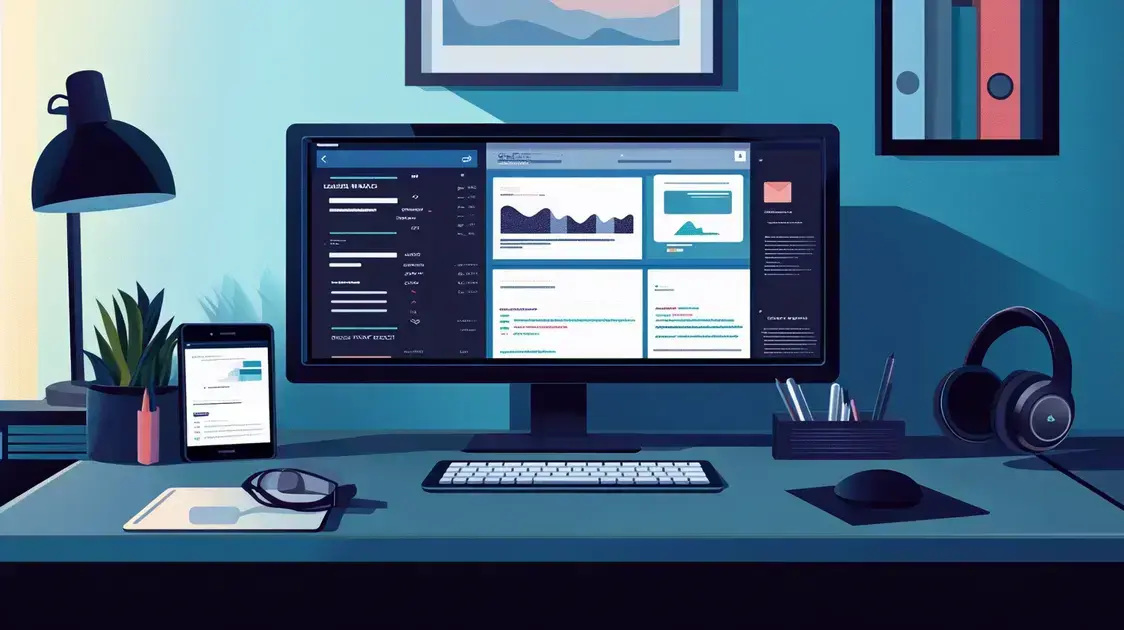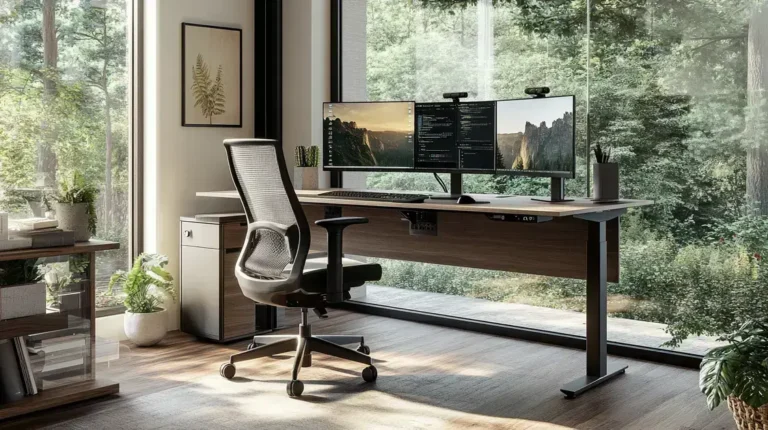Home office productivity is crucial for remote work success. Creating an efficient workspace sets the foundation for a productive day. Small changes, like a dedicated area free from distractions, can significantly improve focus and energy.
The right tools and technology are just as important. Ergonomic furniture, reliable internet, and essential devices help streamline your workday. A well-equipped space supports efficiency and reduces unnecessary stress.
Ready to boost your home office setup? Keep reading for simple yet effective tips to enhance your productivity and create a balanced work environment.
Optimizing Your Home Office Setup
Creating an efficient home office setup is one of the foundational steps to boost home office productivity. Start by selecting a dedicated workspace that is free from distractions and meets your professional needs. A well-organized and ergonomic setup can significantly influence your ability to stay focused and work efficiently.
Lighting and Furniture
Ensure your workspace is well-lit with natural light whenever possible. This not only reduces eye strain but also enhances your mood and overall energy levels. Invest in an ergonomic chair and desk that support proper posture to prevent physical discomfort during long work hours.
Decluttering and Organizing
Keep your workspace tidy and well-organized. Use storage solutions like shelves, drawers, or desktop organizers to avoid unnecessary clutter. A clean and orderly workspace minimizes stress and allows for better concentration.
Personal touches like a small plant or framed photo can also create a pleasant atmosphere while keeping the decor professional to maintain focus. Minimizing distractions by setting boundaries, such as closing the door, or using noise-canceling headphones can further optimize the efficiency of your home office.
Technology and Connectivity
Equip your office setup with the right technology. Reliable high-speed internet, noise-reducing headphones, and essential hardware like a good-quality monitor, keyboard, and mouse are crucial for maintaining productivity. Consider additional tools like a webcam with high resolution for virtual meetings and a printer if your work involves physical documentation.
By creating a home office setup that prioritizes comfort, organization, and functionality, you pave the way for a productive and seamless workday in your remote environment.
Time Management Strategies for Remote Work
Effective time management is critical for maintaining productivity while working remotely. Structuring your day and utilizing techniques that keep you on task can help you accomplish more without feeling overwhelmed.
Set Clear Goals and Priorities
Start your day by outlining clear goals. Use tools such as to-do lists or digital productivity apps to organize your tasks based on urgency and importance. The Eisenhower Matrix, for example, can help you categorize tasks as urgent, important, or both, ensuring you focus on what truly matters and supporting home office productivity.
Embrace Time Blocking
Time blocking is a powerful method for managing remote work. Allocate specific periods in your schedule to complete designated tasks. This practice can prevent multitasking and ensure your energy is dedicated to one activity at a time. Use calendar tools like Google Calendar to visually map out your day.
Establish a Routine
One of the best ways to stay productive is by developing and sticking to a daily routine. Begin your day at the same time every morning, prepare as if you were commuting to work, and allocate a defined start and end time for your work hours. Consistency enhances focus and helps prevent burnout.
Minimize Distractions
Identify and reduce distractions in your home environment. Turn off social media notifications, close irrelevant browser tabs, and communicate boundaries with family or housemates. Utilizing techniques like the Pomodoro Technique, where you work in focused intervals with short breaks in between, can boost overall efficiency.
Efficient time management strategies not only improve workflow but also create a sense of control over your workday, making it easier to balance professional and personal responsibilities, leading to sustained home office productivity.
Essential Tools for Productivity

Having the right tools is essential for maximizing productivity in a home office. From efficient software to reliable hardware, these tools help streamline your workflow and improve overall performance.
Project Management Software
Use tools such as Trello, Asana, or Monday.com to organize and track your projects. These applications allow you to collaborate with team members, set deadlines, and create easy-to-follow workflows that keep you on top of your responsibilities.
Communication Platforms
Effective communication is vital for remote work. Platforms like Zoom, Microsoft Teams, and Slack facilitate seamless video meetings, team discussions, and instant messaging, keeping everyone connected and informed.
Cloud Storage and File Sharing
Cloud-based tools like Google Drive, Dropbox, and OneDrive enable you to securely store, access, and share files from anywhere. These services eliminate the hassle of emailing files back and forth, saving time and reducing miscommunication.
Productivity and Focus Enhancers
Utilize productivity apps like Notion or Evernote for note-taking and task management. For focus, apps like Focus@Will or Freedom can block distracting websites and help you stay on task. A well-curated combination of these tools can significantly enhance your work efficiency.
Reliable Hardware
Invest in high-quality equipment such as a fast laptop or desktop, a dual-monitor setup, noise-canceling headphones, and a webcam with excellent resolution for virtual presentations. A well-functioning printer and scanner may also be necessary for those working with physical documents.
Equipping yourself with these essential tools creates a smoother, more efficient remote work experience. These resources help you stay organized, engaged, and productive without unnecessary interruptions.
Best Practices for Staying Focused
Maintaining focus while working remotely requires adopting strategies to minimize distractions and enhance concentration. Creating a structured approach can significantly improve your ability to stay on task and complete work efficiently, ultimately boosting home office productivity.
Set Specific and Manageable Goals
Break your tasks into smaller, actionable steps. Setting clear goals for each work session can help you stay focused on completing one thing at a time without feeling overwhelmed.
Use Focus-Enhancing Techniques
Incorporate methods like the Pomodoro Technique, which involves working for 25-minute intervals followed by short breaks. This not only keeps your mind fresh but also prevents burnout over extended periods.
Eliminate External Distractions
Reduce interruptions by establishing boundaries with family members or roommates during work hours. Use tools like noise-canceling headphones to block out background noise and create a distraction-free environment to optimize focus.
Declutter Your Workspace
A cluttered workspace can hinder focus and productivity. Keep your desk organized and free from unnecessary items. A clean and tidy space promotes a clear mind and helps you stay on track, enhancing your home office productivity.
Leverage Focus-Boosting Apps
Applications such as Focus@Will, Freedom, or Cold Turkey allow you to block distracting websites and social media during work sessions, helping you remain attentive to your tasks.
Building focus-friendly habits and implementing effective techniques ensures that your work hours are productive and free from unnecessary interruptions, helping you accomplish more in less time.
Creating a Balanced Work-Life Routine
Establishing a balanced work-life routine is essential for maintaining home office productivity and overall well-being while working remotely. Achieving this balance involves setting boundaries and prioritizing self-care alongside professional responsibilities.
Define a Clear Work Schedule
Set consistent working hours and stick to them. Inform colleagues and family members of your schedule to minimize interruptions. Establishing a defined start and end time for your workday will help create separation between your professional and personal life.
Prioritize Daily Breaks
Integrate short breaks throughout your day to re-energize and refocus. Step away from your desk, stretch, or take a walk. Even brief moments of downtime can reduce stress and improve your productivity when you return to work.
Create a Transition Ritual
Develop a routine to signal the start and end of your workday. This could include morning coffee, a short meditation, or a walk after work hours. These rituals help mentally separate work responsibilities from your personal time, contributing to a healthy home office productivity.
Schedule Personal Activities
Dedicate time for hobbies, physical exercise, and social interactions. By including non-work activities in your routine, you create a more fulfilling daily experience and reduce the risk of burnout.
Separate Work and Living Spaces
Whenever possible, maintain distinct areas for work and leisure. A designated workspace helps you focus during work hours, while the rest of your home remains a sanctuary for relaxation and family time.
Following these best practices ensures a balanced routine that keeps you productive without compromising your emotional and physical well-being.
The Role of Breaks in Boosting Efficiency

Taking regular breaks is an essential strategy to maintain and enhance home office productivity while working from home. Breaks provide the mental and physical reset necessary for staying productive throughout the day.
Improving Focus and Mental Clarity
Short breaks help refresh your mind and improve focus. Stepping away from work for even a few minutes can increase clarity and reduce mental fatigue, enabling you to tackle tasks with renewed energy.
Preventing Burnout
Working for extended periods without rest can lead to burnout. Adding a mix of short and longer breaks into your day allows you to recharge, reducing stress and ensuring sustained productivity over time.
Using Breaks for Physical Movement
Incorporate physical activity during breaks, such as stretching or taking a quick walk. Movement boosts circulation, reduces tension, and counteracts the negative effects of prolonged sitting, ultimately enhancing both physical and mental performance, which directly contributes to home office productivity.
The Science of Break Intervals
Techniques like the Pomodoro Method emphasize working in focused intervals, such as 25-30 minutes, followed by a 5-minute break. This approach keeps your brain engaged and helps you maintain steady productivity throughout your workday.
Engaging in Mindfulness or Relaxation
Consider using breaks to practice mindfulness or relaxation exercises. Activities like meditation, deep breathing, or listening to calming music can help reduce stress and improve overall mood, making it easier to stay productive.
Regular, intentional breaks are a powerful tool in managing energy levels and preventing performance dips. By building their role into your daily routine, you create a workflow that encourages long-term efficiency and job satisfaction.
Overcoming Home Office Challenges
Working from home comes with unique challenges, but with the right strategies, these obstacles can be effectively managed to preserve productivity and comfort.
Managing Distractions
Distractions like household chores or interruptions from family members can derail your focus. Establish clear boundaries by setting specific work hours and communicating them with others in your home. For added focus, use tools like noise-canceling headphones or create a designated workspace free from distractions.
Combating Isolation
Remote work can sometimes feel isolating. Stay connected with coworkers through regular video meetings or chats. Engaging in virtual coffee breaks or team-building activities helps maintain a sense of camaraderie and connection.
Dealing with Technical Issues
Technology-related problems, such as slow internet or malfunctioning devices, can disrupt productivity. Invest in reliable hardware and a strong internet connection. Keep backup solutions like a mobile hotspot or a secondary device to avoid extended downtime.
Staying Motivated
It’s easy to lose a sense of drive without the structure of an office environment. Set daily or weekly goals to create a sense of achievement. Rewarding yourself upon completing tasks can also help maintain motivation.
Maintaining Health and Well-Being
Long hours at your desk can lead to physical strain. Use ergonomic furniture to support your posture and take regular stretch breaks. Staying hydrated, eating balanced meals, and including physical activity in your routine promotes overall well-being.
By addressing these common challenges head-on, you can create an effective and productive home office productivity environment while maintaining a healthy work-life balance.
Additionally, adopting strategies to boost home office productivity will help you stay on top of your tasks and maintain a balanced approach to remote work.
Achieving Success in Your Home Office
Boosting home office productivity requires the right combination of strategies, tools, and habits. From optimizing your workspace to mastering time management, each element plays a crucial role in creating an efficient work environment.
Incorporating essential tools, adopting best practices for focus, and taking intentional breaks help maintain both productivity and well-being. Overcoming challenges such as distractions, isolation, and technical issues ensures that remote work not only becomes manageable but also rewarding.
By creating a balanced work-life routine and leveraging the strategies discussed, you can transform your home office into a space that fosters success, efficiency, and personal satisfaction. Take charge of your remote work routine and thrive in your professional and personal life.

